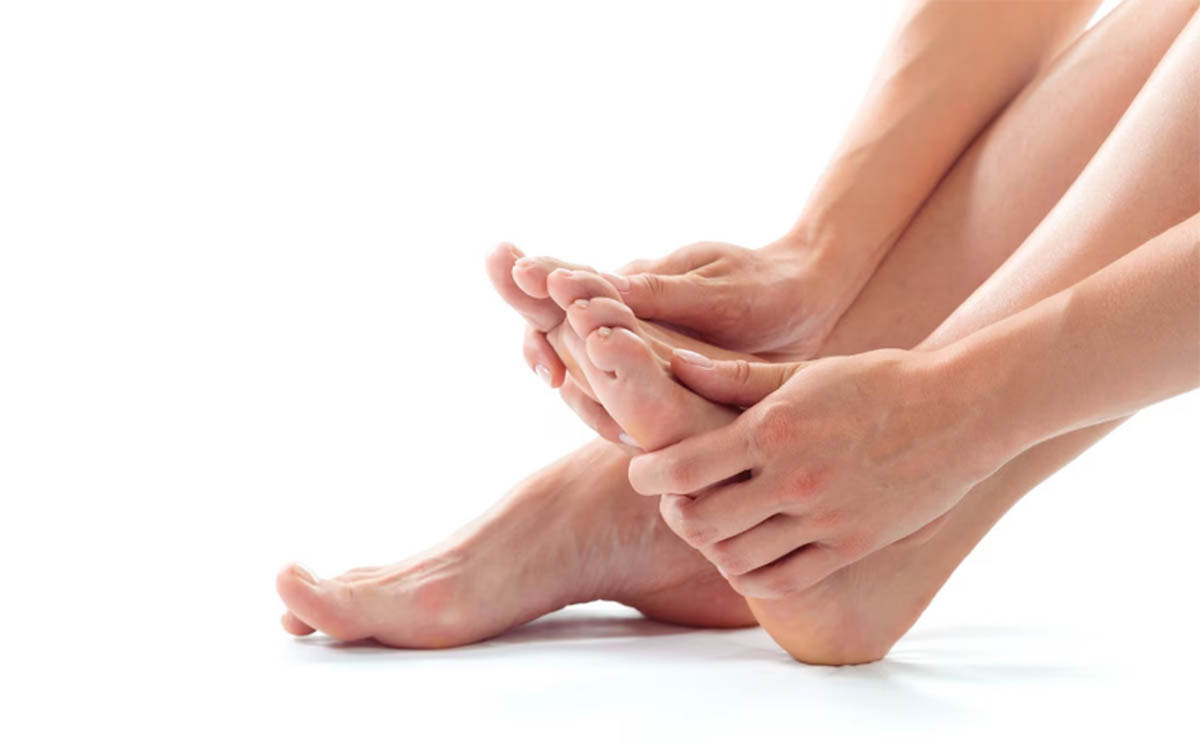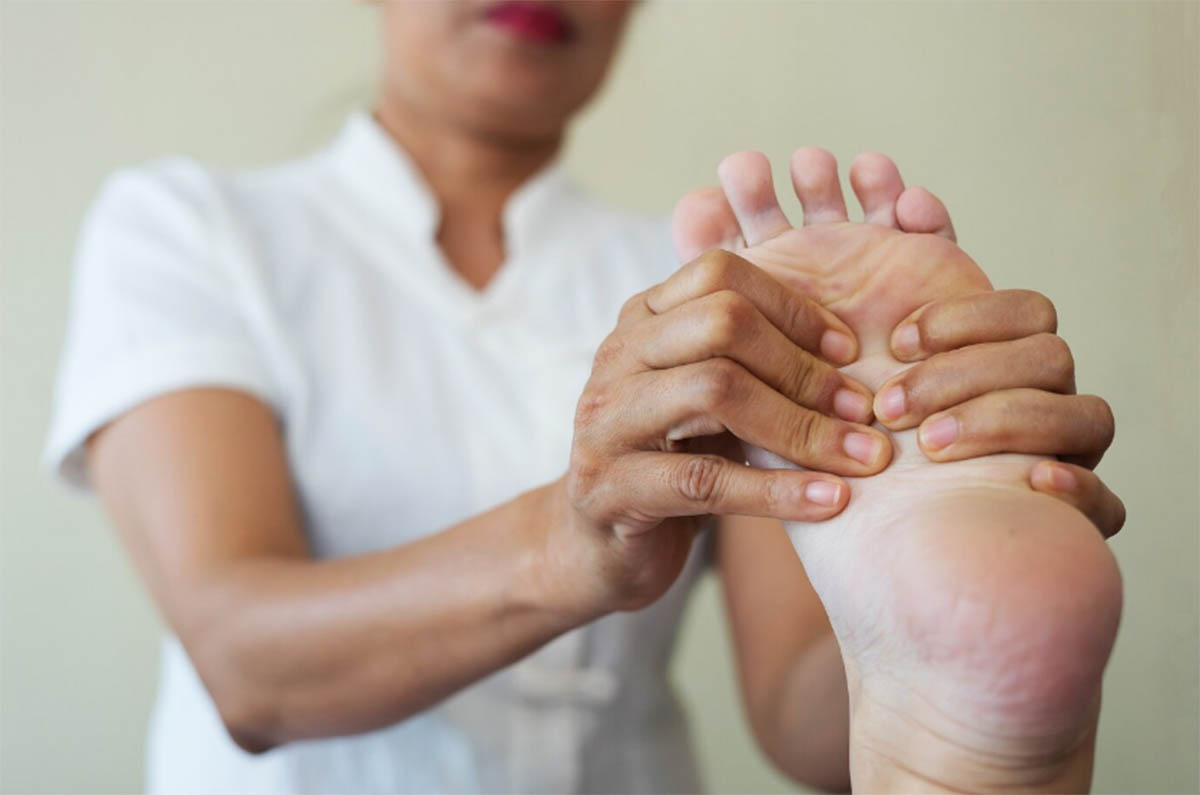Introduction
Foot strain is a common condition affecting individuals of all ages and lifestyles, leading to discomfort and hindering daily activities. This condition, often overlooked until it becomes severe, can significantly impact one’s quality of life. Understanding this foot condition’s causes, symptoms, and treatment options is essential for anyone looking to maintain foot health and prevent future injuries.
Our comprehensive guide delves into every aspect of foot strain, offering insights and solutions to help you or someone you care about find relief and achieve optimal foot health.
What is Foot Strain?
Foot strain is a condition characterized by the overstressing or tearing of muscles in the foot. This ailment is distinct from other foot-related injuries, such as foot fractures or foot sprains, which involve bones and ligaments. According to Milford Podiatry Associates, every year, approximately 19 percent of the United States population experiences 1.4 foot problems. This highlights how common issues with foot health are, including strains.
The complexity of the foot’s structure, comprising numerous muscles, tendons, and ligaments, makes it susceptible to strain, especially among individuals engaged in activities that place excessive demand on their feet. Understanding foot strain is the first step toward effective management, ensuring that the muscle strain in the foot does not impede your daily activities or diminish your quality of life.
Causes of Foot Strain
Overuse and Repetitive Activities
One of the primary catalysts for foot strain is the overuse of foot muscles through repetitive activities. Athletes, dancers, and individuals whose professions require extended periods of standing or walking are particularly at risk. Activities such as long-distance running, ballet, soccer, and even routine exercises like jogging can cumulatively exert excessive stress on the foot muscles, leading to strain. It’s not just the intensity but also the frequency and duration of these activities that contribute to the condition.
Improper Footwear
Another significant contributor to foot strain is wearing improper footwear. Shoes that lack sufficient support or do not fit well can worsen the strain on foot muscles and tendons. It’s noteworthy that one-third of older adults suffer from foot discomfort, stiffness, or hurting feet, many of which can be attributed to poorly fitting shoes. For instance, high heels, which shift the body’s weight to the forefoot, can increase tension in the foot’s muscles, while overly flat shoes might not offer enough arch support.
Choosing the right footwear involves considering factors such as arch support, cushioning, and the activity for which the shoes will be used. Proper footwear not only helps prevent foot strain but also relieves symptoms if the condition arises.
Biomechanical Issues
Biomechanical issues in the feet, such as flat feet, high arches, or overpronation, can significantly increase the risk of developing a strained foot. These conditions alter the normal distribution of weight and stress across the foot. This leads to overcompensation by certain muscles and, eventually, strain. Preventative measures include wearing orthotic devices designed to correct the specific biomechanical issue, selecting footwear that provides adequate support, and engaging in exercises that strengthen foot muscles, reducing the likelihood of strain.
Symptoms of Foot Strain

Description of Symptoms
Recognizing the foot strain symptoms is crucial for timely intervention and treatment. Common signs include:
Pain and Tenderness
The affected area may feel painful to touch, and the pain can worsen with movement or when bearing weight on the foot.
Swelling
Mild to moderate swelling can occur around the strained muscles or tendons, contributing to discomfort.
Bruising
In some cases, bruising may be visible on the skin over the strained area, indicating underlying tissue damage.
Reduced Range of Motion
You may experience difficulty moving the foot or ankle as freely as usual, which can affect your gait and mobility.
Weakness
The foot may feel weaker than normal. This makes it challenging to perform certain movements or activities.
Instability
A sensation of instability or giving way may be present, especially when standing, walking, or changing directions.
How Symptoms Vary in Severity or Over Time
Initial Onset
Initially, symptoms may be mild and worsen with continued physical activity.
Severity
The severity of symptoms can vary widely. It depends on the extent of the muscle strain in foot and individual pain tolerance.
Progression Without Treatment
Without proper treatment, symptoms can escalate. This leads to increased pain, swelling, and decreased mobility.
Variation Over Time With Treatment
With appropriate treatment, symptoms should gradually decrease in severity. Full recovery times can vary.
Chronic Issues
If not adequately addressed, foot strain can become a recurring problem, leading to chronic pain and instability.
Diagnosing Foot Strain
A thorough assessment by a healthcare professional is necessary to diagnose foot strain accurately. This process typically involves:
Physical Examination
The doctor will examine the foot for signs of swelling, bruising, and tenderness and assess the range of motion and strength.
Medical History Review
Discussing your health history, including any previous foot injuries or conditions, helps the doctor understand potential risk factors.
Imaging Tests
In some cases, X-rays, Magnetic Resonance Imaging (MRI), or ultrasounds are required to rule out fractures, sprains, or other severe injuries.
Biomechanical Assessment
Evaluating the foot’s biomechanics can identify underlying issues contributing to the strain, such as gait abnormalities.
Common Misdiagnoses or Challenges
Diagnosing foot strain can be complicated by the similarity of its symptoms to those of other foot conditions. Understanding these potential misdiagnoses is important for both health care providers and patients to ensure that the correct foot strain treatment plan is implemented.
Plantar Fasciitis
This condition involves inflammation of the plantar fascia, a thick band of tissue that runs across the bottom of your foot and connects your heel bone to your toes. While plantar fasciitis primarily causes pain in the heel, it can be confused with foot strain due to the overlap in symptoms, such as pain and tenderness in the foot.
Stress Fractures
Stress fractures are tiny cracks in a bone, often developing from overuse, such as repetitive jumping activities or long-distance running. These bone fractures can occur in the foot and mimic the pain and discomfort associated with a muscle strain, leading to potential misdiagnosis.
Tendonitis
Tendonitis in the foot involves inflammation or irritation of a tendon, which can cause pain and swelling similar to that of a foot strain. It’s particularly common in the Achilles tendon but can occur in other tendons of the foot as well.
Sprains
A sprain refers to the stretching or torn ligaments—the tough bands of fibrous tissue that connect bones to each other in a joint. Ankle sprains are especially common foot injuries and can present symptoms that closely resemble those of a foot strain, such as pain, swelling, and limited mobility.
Treatment Options for Foot Strain
Effective treatment of foot strain involves a combination of immediate medical care, ongoing management, and sometimes medical intervention, depending on the severity of the strain. These strategies aim to relieve pain, reduce inflammation, and promote healing, ensuring a return to normal activities as safely and quickly as possible.
Immediate Care (R.I.C.E. Method)
The R.I.C.E. method is a widely recommended initial treatment for foot strain, emphasizing four key steps:
- Rest: Cease any activities that worsen the foot strain to prevent further injury.
- Ice: Apply ice packs to the affected area for 20 minutes at a time, several times a day, to reduce swelling and relieve pain.
- Compression: Use an elastic bandage to wrap the foot lightly, helping to minimize swelling and provide support.
- Elevation: Keep the foot raised above heart level as much as possible to decrease swelling and discomfort.
Medication
For pain relief and to reduce inflammation, over-the-counter anti-inflammatory medication such as ibuprofen or naproxen sodium can be beneficial. Always follow the recommended dosages and consider consulting with a healthcare provider before starting any new medicine for pain.
Physical Therapy
Physical therapy plays a crucial role in the recovery process for foot strain, offering tailored exercises and techniques to strengthen the foot, improve flexibility, and restore function. A physical therapist may also employ modalities such as ultrasound therapy or electrical stimulation to promote healing.
Supportive Devices
In some cases, using supportive devices like orthotic inserts, braces, or specialized footwear can provide additional stability and support to the foot, aiding in recovery. These devices can also help prevent future strain by correcting biomechanical issues that may have contributed to the injury.
Surgical intervention (for severe cases)
Surgery is rarely required for foot strain but may be considered in severe cases where conservative treatments have not led to improvement. This might include situations where there is significant damage to the muscles or tendons. Surgical options will depend on the specific type of injury and are typically followed by a period of rehabilitation.
Prevention of Foot Strain
To effectively prevent foot strain and maintain overall foot health, it’s crucial to adopt a series of proactive measures. These strategies not only minimize the risk of injury but also enhance the strength and flexibility of your feet. Here are essential practices to incorporate:
Wearing Appropriate Footwear
- Select shoes that provide adequate support for your activities.
- Ensure shoes fit well to avoid unnecessary pressure on the feet.
Incorporating Proper Warm-up and Cool-down Routines
- Start each physical activity session with gentle stretches and warm-up exercises.
- End activities with cool-down exercises to relax and stretch the foot muscles.
Understanding and Recognizing Your Physical Limits
- Listen to your body and avoid pushing beyond your comfort level.
- Gradually increase the intensity and duration of activities to prevent overuse injuries.
Specific Exercises for Prevention of Foot Strain

Preventing foot strain not only involves wearing the right footwear and being mindful of your activities but also incorporating exercises that strengthen and improve the flexibility of your feet. Here are some effective exercises designed to prevent this condition:
Toe Grips
Place small objects, like marbles or a towel, on the floor and use your toes to pick them up. This exercise strengthens the muscles under your feet.
Heel Raises
Stand with your feet shoulder-width apart and slowly raise your heels off the ground, then lower them. This strengthens the muscles around your ankle and improves stability.
Ankle Circles
Lift one foot off the ground and rotate your ankle in a circular motion. Switch directions after several rotations. Repeat with the other foot. This enhances ankle mobility and flexibility.
Toe Spreads
While seated or standing, spread your toes as wide as possible, hold for a few seconds, and then relax them. This exercise improves control over the foot muscles.
Arch Lifts
Stand with your feet flat on the ground. Without lifting your toes, raise the arches of your feet as high as you can then lower them. This strengthens the arches and the muscles of the foot.
Balancing Exercises
Stand on one foot while maintaining your balance. Try to hold the position for at least 30 seconds, then switch feet. This improves foot strength and stability.
Walking Barefoot on Different Surfaces
Walking barefoot on grass, sand, or other soft surfaces helps strengthen the foot muscles and improves proprioception.
Foot Flexion and Extension
Flex and extend your toes, moving them up and down to improve their range of motion and flexibility.
Achilles Tendon Stretch
Stand with one foot behind the other and gently push your back heel towards the ground, feeling a stretch in your Achilles tendon and calf muscle.
Incorporating these exercises into your daily routine can significantly reduce the risk of experiencing foot strain by strengthening the muscles and tendons in your feet, improving flexibility, and enhancing overall foot health.
Ease Foot Strain with Mitchell Holistic Health
If you are suffering from a foot strain and are looking for effective treatment options, look no further than Mitchell Holistic Health. Our team offers comprehensive physical therapy services, staffed by experienced physical therapists who can provide you with personalized care and exercises designed to strengthen your foot and prevent future injuries. Don’t let foot pain hold you back any longer – schedule an appointment with us and take the first step towards a healthier, pain-free life.
Conclusion
Understanding foot strain, its causes, symptoms, and the variety of treatment options available is crucial for anyone seeking relief from this common condition. By adopting preventive measures, including proper footwear, routine exercises, and considering physical therapy tips, individuals can significantly reduce their risk of this condition and maintain optimal foot health.
Remember, if you suspect you have a strain on the foot, seeking professional medical advice is essential to ensure an accurate diagnosis and appropriate foot strain treatment plan.
FAQs
How long can a foot strain last?
The recovery time for a foot strain can vary depending on its severity and the treatment approach. Generally, mild strains may heal within a few weeks, while more severe strains could take several months.
Can I walk on a sprained foot?
Walking on a sprained foot is not advised until it has been evaluated by a healthcare professional. Doing so could worsen the injury and prolong recovery time.
How do I know if my foot injury is serious?
Signs that a foot injury may be serious include severe pain, inability to bear weight, noticeable deformities in the injured foot, and symptoms that do not improve with rest and home treatment. If you experience any of these symptoms, seek medical attention promptly.


